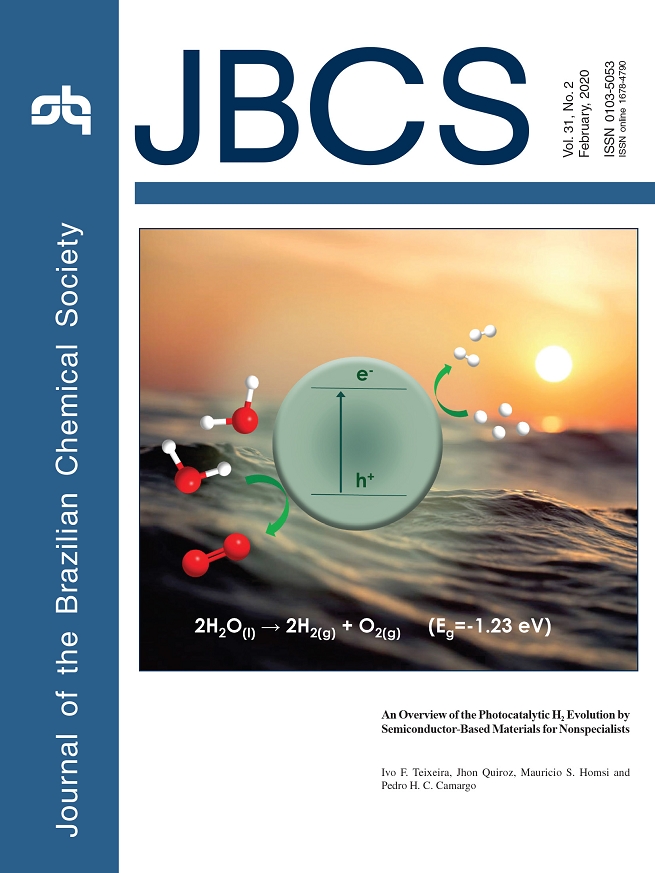vol. 31, No. 2, 2020, p. 211-428
This figure illustrates the generation of charge carriers in semiconductor photocatalyst nanoparticles as a result of band gap excitation by sunlight. These charge carriers can then be employed to promote the water splitting reaction for the generation of H2. This transformation is of paramount importance to the solar-to-chemical energy conversion. We review herein the fundamentals of H2 generation from water splitting and representative classes of photocatalytic materials. Details are presented in the Review An Overview of the Photocatalytic H2 Evolution by Semiconductor-Based Materials for Nonspecialists by Ivo F. Teixeira, Jhon Quiroz, Mauricio S. Homsi and Pedro H. C. Camargo on page 211.
An Overview of the Photocatalytic H2 Evolution by Semiconductor-Based Materials for Nonspecialists
Ivo F. Teixeira  ; Jhon Quiroz; Mauricio S. Homsi; Pedro H. C. Camargo
; Jhon Quiroz; Mauricio S. Homsi; Pedro H. C. Camargo
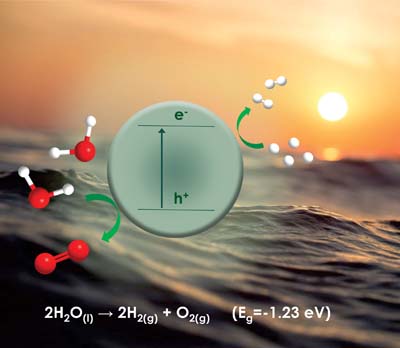
This figure illustrates the generation of charge carriers in semiconductor photocatalyst nanoparticles as a result of band gap excitation by sunlight. These charge carriers can then be employed to promote the water splitting reaction for the generation of H2. This transformation is of paramount importance to the solar-to-chemical energy conversion. We review herein the fundamentals of H2 generation from water splitting and representative classes of photocatalytic materials. Details are presented in the Review An Overview of the Photocatalytic H2 Evolution by Semiconductor-Based Materials for Nonspecialists by Ivo F. Teixeira, Jhon Quiroz, Mauricio S. Homsi and Pedro H. C. Camargo on page 211.
https://dx.doi.org/10.21577/0103-5053.20190255
Review J. Braz. Chem. Soc. 2020, 31(2), 211-229
An Overview of the Photocatalytic H2 Evolution by Semiconductor-Based Materials for Nonspecialists
Ivo F. Teixeira  ; Jhon Quiroz; Mauricio S. Homsi; Pedro H. C. Camargo
; Jhon Quiroz; Mauricio S. Homsi; Pedro H. C. Camargo
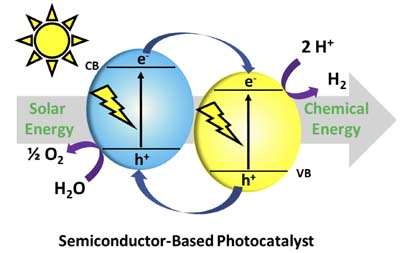
We review semiconductor photocatalysts for the H2 evolution reaction that have displayed the best reported activities and quantum efficiencies.
https://dx.doi.org/10.21577/0103-5053.20190255
J. Braz. Chem. Soc. 2020, 31(2), 230-243
Recent Developments on the Elucidation of Colloidal Aspects of Asphaltenes and Their Relevance to Oilfield Problems
Lia B. S. Balestrin  ; Watson Loh
; Watson Loh

This review discusses colloidal aspects of crude oil asphaltenes and their impact on oil production issues.
https://dx.doi.org/10.21577/0103-5053.20190257
Articles J. Braz. Chem. Soc. 2020, 31(2), 244-264
An Acetal Acylation Methodology for Producing Diversity of Trihalomethyl- 1,3‑dielectrophiles and 1,2-Azole Derivatives
Valéria D. O. Bareño; Daiane S. Santos; Leandro M. Frigo; Debora L. de Mello; Juliana L. Malavolta; Rogerio F. Blanco; Lucas Pizzuti; Darlene C. Flores; Alex F. C. Flores
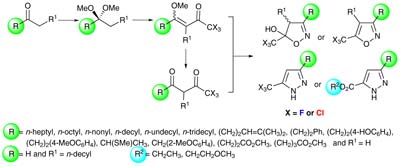
The goal is to demonstrate the scope of the practical acetal acetylation methodology for synthesis of trihalomethyl substituted 1,3-dielectrophiles and their versatility in the preparation of 1,2-azoles.
https://dx.doi.org/10.21577/0103-5053.20190160
J. Braz. Chem. Soc. 2020, 31(2), 265-272
Development and Validation of a UPLC-ESI-MS Method for Quantitation of the Anti-Alzheimer Drug Galantamine and other Amaryllidaceae Alkaloids in Plants
José R. de Paiva; Ana S. Q. Souza; Rita C. A. Pereira; Paulo R. V. Ribeiro; Guilherme J. Zocolo ; Edy S. de Brito
; Edy S. de Brito ; Otília D. L. Pessoa
; Otília D. L. Pessoa ; Kirley M. Canuto
; Kirley M. Canuto
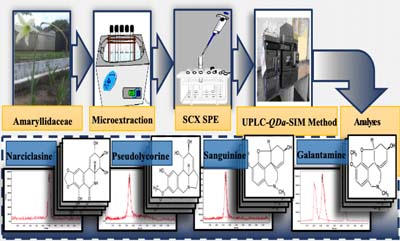
Ultra-performance liquid chromatography coupled to mass spectrometry (UPLC-ESI-MS) method for quantitation of Amaryllidaceae alkaloids.
https://dx.doi.org/10.21577/0103-5053.20190162
J. Braz. Chem. Soc. 2020, 31(2), 273-279
Sustainability of Biorefinery Processes Based on Baru Biomass Waste
Magale K. D. Rambo  ; Michele C. D. Rambo; Polyana M. Melo; Nayra Morgana L. de Oliveira; Yara K. S. Nemet; Elisandra Scapin; Guenther C. C. Viana; Daniel A. Bertuol
; Michele C. D. Rambo; Polyana M. Melo; Nayra Morgana L. de Oliveira; Yara K. S. Nemet; Elisandra Scapin; Guenther C. C. Viana; Daniel A. Bertuol
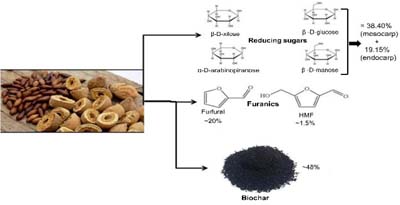
Brazilian Cerrado biomass waste was evaluated as potential raw-material for biofuel and bioproduct production in biorefineries.
https://dx.doi.org/10.21577/0103-5053.20190169
J. Braz. Chem. Soc. 2020, 31(2), 280-287
Synthesis and Evaluation of Fenofibric Acid Ester Derivatives: Studies of Different Formulation with Their Bioavailability and Absorption Conditions
Zhixiang Lv; Zhou Wang; Fuyan Xiao; Guofan Jin
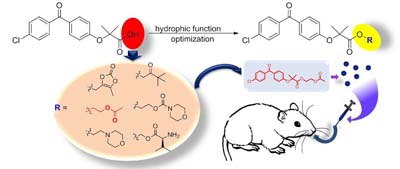
A series of fenofibric acid ester pro-drugs were synthesized. The oral administration (20 mg kg-1) of JF-2 showed a relative bioavailability of approximately 272.8% compared to fenofibrate.
https://dx.doi.org/10.21577/0103-5053.20190170
J. Braz. Chem. Soc. 2020, 31(2), 288-297
A New Strategy for the Synthesis of Nonsymmetrical 3,3'-(Aryl/alkyl-methylene) bis-2-hydroxy-1,4-naphthoquinones and Their Cytotoxic Effects in PC3 Prostate Cancer Cells
Ruan Carlos B. Ribeiro; Paula Priscilla de Freitas; Caroline S. Moreira; Leonardo G. C. de Moraes; Matheus G. de Moraes; Fernando C. da Silva  ; David R. Rocha; Etel R. P. Gimba; Vitor F. Ferreira
; David R. Rocha; Etel R. P. Gimba; Vitor F. Ferreira
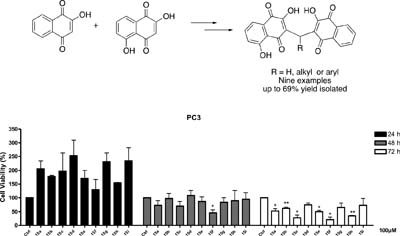
A novel method for the synthesis of nonsymmetrical 3,3'-(aryl/alkyl-methylene)bis-2-hydroxy-1,4-naphthoquinones was developed by using the Mannich adduct of naphthoquinone and the reaction with another moiety of 2-hydroxy-1,4-naphthoquinone.
https://dx.doi.org/10.21577/0103-5053.20190172
J. Braz. Chem. Soc. 2020, 31(2), 298-304
Quantification of Glyphosate and AMPA by HPLC-ICP-MS/MS and HPLC-DAD: A Comparative Study
Emanuella M. Pimenta; Fabio F. da Silva; Érica S. Barbosa; Ane P. Cacique; Douglas L. Cassimiro; Gevany P. de Pinho; Flaviano O. Silvério
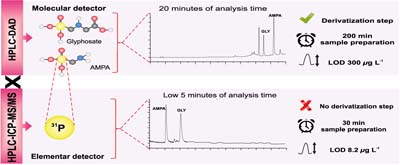
The image represents the parameters in which high performance liquid chromatography using inductively coupled plasma with triple quadrupole mass spectrometer (HPLC-ICP-MS/MS) was superior to high performance liquid chromatography with diode array detector (HPLC-DAD) in determining glyphosate and aminomethylphosphonic acid (AMPA).
https://dx.doi.org/10.21577/0103-5053.20190175
J. Braz. Chem. Soc. 2020, 31(2), 305-312
A Highly Selective Colorimetric Sensor for Cysteine Detection
Mengjiao Peng  ; Hui Wang; Gregory L. Gibson; Hua Shang; Jianmin Yang; Yan Chen; Yin Lu
; Hui Wang; Gregory L. Gibson; Hua Shang; Jianmin Yang; Yan Chen; Yin Lu

Cysteine (Cys) can release CuII ion from the non-fluorescent a-CuII complex. Then hydrolytic cleavage of Schiff base (E)-2-(6-(diethylamino)-2-((2-hydroxyphenylimino)methyl)-3-oxo-3H-xanthen-9-yl)benzoic acid (a) produces a pink fluorescent compound 2-(6-(diethylamino)-2-formyl-3-oxo-3H-xanthen-9-yl)benzoic acid (2). Thus, Cys residues act as a “switch” in an off-on fluorescence system.
https://dx.doi.org/10.21577/0103-5053.20190177
J. Braz. Chem. Soc. 2020, 31(2), 313-319
Mathematical Modeling of the Transesterification Reaction by Finite Elements: Optimization of Kinetic Parameters Using the Simplex Sequential Method
Diego Galvan; Letícia Thaís Chendynski; Ana Carolina G. Mantovani; Marintho B. Quadri; Mário Killner; Hágata Cremasco; Dionisio Borsato
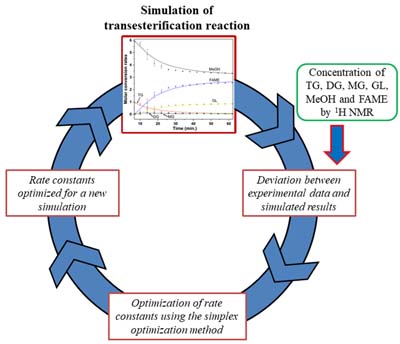
The transesterification reaction of soybean oil was modeled considering the 3 steps of the direct and reverse reactions following a second order general kinetics by the finite element method.
https://dx.doi.org/10.21577/0103-5053.20190180
J. Braz. Chem. Soc. 2020, 31(2), 320-330
Preparation and Delayed Release Study on Pancreatin Encapsulated into Alginate, Carrageenan and Pectin Hydrogels
Fernanda M. P. Olímpio; Adriano A. Mendes; Marcello G. Trevisan  ; Jerusa S. Garcia
; Jerusa S. Garcia
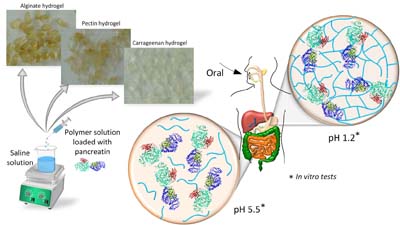
Three hydrogels were prepared and applied in pancreatin encapsulation. Alginate hydrogel presented better encapsulation efficiency and enzyme release representing as an alternative to replace the commercial formulation.
https://dx.doi.org/10.21577/0103-5053.20190184
J. Braz. Chem. Soc. 2020, 31(2), 331-340
GC-MS-Based Metabolomic Profiles Combined with Chemometric Tools and Cytotoxic Activities of Non-Polar Leaf Extracts of Spondias Mombin L. and Spondias Tuberosa Arr. Cam.
Jhonyson A. C. Guedes  ; Elenilson G. Alves Filho
; Elenilson G. Alves Filho  ; Maria F. S. Silva; Tigressa H. S. Rodrigues; Christiane M. C. Ramires; Maria A. C. Lima; Gisele S. Silva; Cláudia O. Pessoa; Kirley M. Canuto; Edy S. Brito; Ricardo E. Alves; Ronaldo F. Nascimento; Guilherme J. Zocolo
; Maria F. S. Silva; Tigressa H. S. Rodrigues; Christiane M. C. Ramires; Maria A. C. Lima; Gisele S. Silva; Cláudia O. Pessoa; Kirley M. Canuto; Edy S. Brito; Ricardo E. Alves; Ronaldo F. Nascimento; Guilherme J. Zocolo
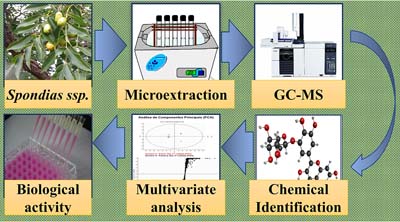
Analytical procedures, from the collection of samples to the correlation of chemical identification with biological activity.
https://dx.doi.org/10.21577/0103-5053.20190185
J. Braz. Chem. Soc. 2020, 31(2), 341-350
Characterizing the Chemical Composition of Lipophilic Extracts from Acacia mearnsii Wood
Gliciane R. A. Oliveira; Fábio S. Grasel  ; Gevany P. de Pinho; Flaviano O. Silvério
; Gevany P. de Pinho; Flaviano O. Silvério
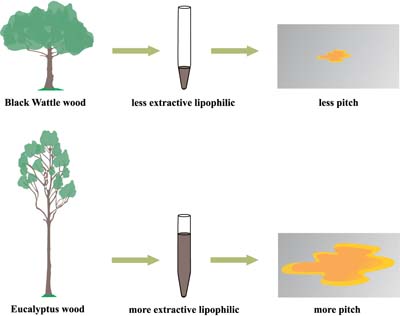
The constituents that can generate the pitch are in smaller quantities in the extracts of Acacia mearnsii wood in relation to the eucalyptus wood.
https://dx.doi.org/10.21577/0103-5053.20190186
J. Braz. Chem. Soc. 2020, 31(2), 351-356
Integrative Approach Based on Simplex-Centroid Design, ESI-MS and Chemometric Analysis for Comprehensive Characterization of Phenolic Compounds from Endopleura uchi Bark
Lílian M. Bastos  ; Felipe M. A. da Silva
; Felipe M. A. da Silva  ; Leonard R. S. de Souza; Ingrity S. C. Sá; Rochelly S. Mesquita; Afonso D. L. de Souza; Rita de Cássia S. Nunomura
; Leonard R. S. de Souza; Ingrity S. C. Sá; Rochelly S. Mesquita; Afonso D. L. de Souza; Rita de Cássia S. Nunomura
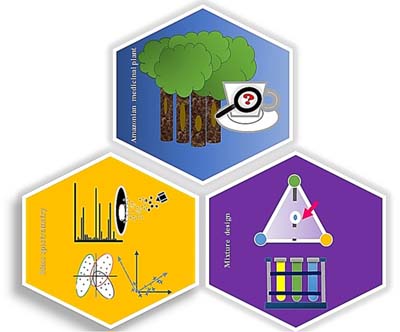
The integrative approach based on simplex-centroid design, electrospray ionization mass spectrometry (ESI-MS), and multivariate analysis provided an effective way to assess the phenolic composition of Endopleura uchi bark.
https://dx.doi.org/10.21577/0103-5053.20190187
J. Braz. Chem. Soc. 2020, 31(2), 357-363
Pumilacidins A-E from Sediment-Derived Bacterium Bacillus sp. 4040 and Their Antimicrobial Activity Evaluation
Josiane A. M. de Oliveira; David E. Williams; Raymond J. Andersen; Maria H. Sarragiotto; Debora C. Baldoqui
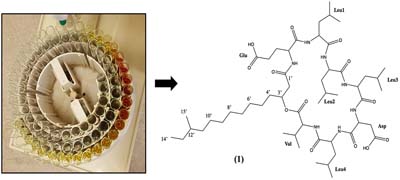
A series of pumilacidins were isolated from the solid culture of the marine-derived bacterium Bacillus sp. 4040. The structures were determined using a combination of mass spectrometry, nuclear magnetic resonance (NMR) spectroscopy and comparison with reported data.
https://dx.doi.org/10.21577/0103-5053.20190188
J. Braz. Chem. Soc. 2020, 31(2), 364-369
Aromatic Polyketides and Macrolides from Microsphaeropsis arundinis
Weslei Bruno Botero; Marcelo R. de Amorim; Iracilda Z. Carlos; Marisa C. Polesi; Lourdes C. dos Santos
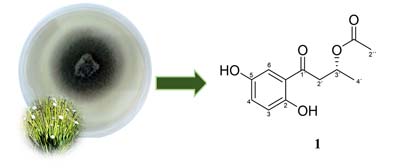
A novel aromatic polyketide isolated from Microsphaeropsis arundinis.
https://dx.doi.org/10.21577/0103-5053.20190189
J. Braz. Chem. Soc. 2020, 31(2), 370-380
Evaluation of a Graphite-Polyurethane Composite Electrode Modified with Copper Nanoparticles as an Amperometric Flow Detector in a Wall-Jet System for the Determination of Cysteine
Isabela A. Mattioli; Letícia F. L. Schildt; Priscila Cervini; Thalita R. Saciloto; Éder T. G. Cavalheiro
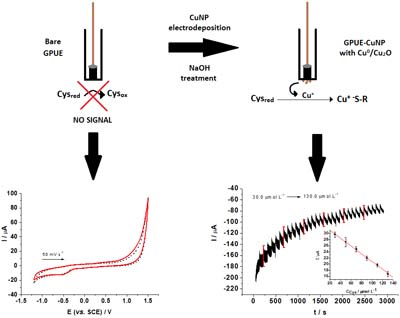
Cysteine (Cys) does not present voltammetric response at bare graphite-polyurethane composite electrode (GPUE) or even at non-treated GPUE containing electrodeposited copper nanoparticles (CuNP). When GPUE-CuNP is electrochemically pretreated in basic medium the Cys response can be observed based on its interaction with Cu oxides at electrode surface allowing analytical applications in an amperometric wall-jet procedure.
https://dx.doi.org/10.21577/0103-5053.20190191
J. Braz. Chem. Soc. 2020, 31(2), 381-393
Experimental and Theoretical Study of LiMn2O4 Synthesized by the Solution Combustion Method Using Corn Starch as Fuel
José M. Siqueira Jr  ; Carolina T. Machado; Daniel S. G. Quattrociocchi; Francisco M. S. Garrido; Leonardo M. da Costa; Eduardo A. Ponzio; Glaucio B. Ferreira
; Carolina T. Machado; Daniel S. G. Quattrociocchi; Francisco M. S. Garrido; Leonardo M. da Costa; Eduardo A. Ponzio; Glaucio B. Ferreira  ; Jackson A. L. C. Resende
; Jackson A. L. C. Resende

LiMn2O4 was synthesized by the solution combustion method using corn starch as fuel with temperature below 700 °C. This synthesis is ecofriendly and has a lower cost than the standard methods. The influence of the Li+ cations amount on the MnO2 oxide structural and electronic properties was also evaluated by the density functional theory (DFT) method.
https://dx.doi.org/10.21577/0103-5053.20190192
J. Braz. Chem. Soc. 2020, 31(2), 394-401
Ethanol Content Determination in Medicine Syrups Using Headspace and Multidimensional Heart-Cut Gas Chromatography Coupled to Mass Spectrometry
Lilian R. Batista  ; Nelson R. Antoniosi Filho
; Nelson R. Antoniosi Filho
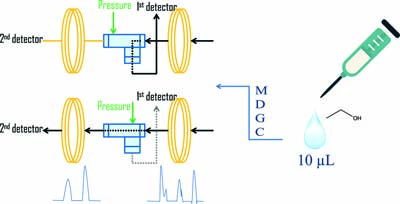
Multidimensional gas chromatography method for ethanol monitoring in medicated syrups in order to question quality certificates from regulatory agencies.
https://dx.doi.org/10.21577/0103-5053.20190193
J. Braz. Chem. Soc. 2020, 31(2), 402-408
Structural Study of Phenolic Acids by Triple Quadrupole Mass Spectrometry with Electrospray Ionization in Negative Mode and H/D Isotopic Exchange
Nayane B. M. Sinosaki; Angélica P. P. Tonin; Marcos A. S. Ribeiro; Camila B. Poliseli; Sharise B. Roberto  ; Roberta da Silveira; Jesuí V. Visentainer; Oscar O. Santos
; Roberta da Silveira; Jesuí V. Visentainer; Oscar O. Santos  ; Eduardo C. Meurer
; Eduardo C. Meurer
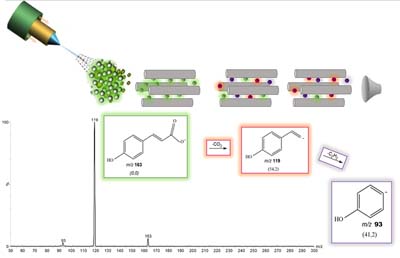
Five phenolic acids were evaluated according to the fragmentation profile by collision-induced dissociation (CID) using triple quadrupole mass spectrometry by electrospray ionization in negative ionic mode (ESI(−)-MS/MS), combined with thermochemical data obtained by computational chemistry and hydrogen by deuterium (H/D) exchange.
https://dx.doi.org/10.21577/0103-5053.20190197
J. Braz. Chem. Soc. 2020, 31(2), 409-420
PMMA-SiO2 Organic-Inorganic Hybrid Coating Application to Ti-6Al-4V Alloy Prepared through the Sol-Gel Method
Joseane A. Santana; Sandra R. Kunst; Cláudia T. Oliveira; Antonio A. Bastos; Mario G. S. Ferreira  ; Victor H. V. Sarmento
; Victor H. V. Sarmento
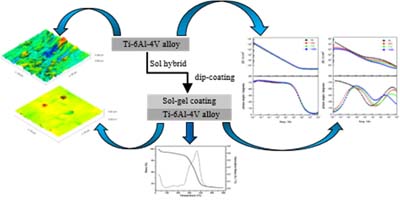
Hybrid coating application to Ti-6Al-4V alloy prepared through the sol-gel method.
https://dx.doi.org/10.21577/0103-5053.20190198
J. Braz. Chem. Soc. 2020, 31(2), 421-428
Thermal Infrared Enthalpimetry in Paper Microzone Plates for Green and High Throughput Determination of Wine Acidities
Daniele F. Ferreira; Bruna Tischer; Alexandre J. Cichoski; Cristiano R. Menezes; Roger Wagner; Adilson B. Costa; Juliano S. Barin
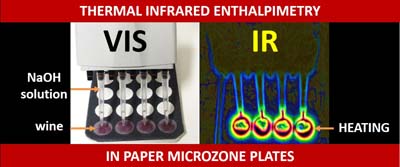
Wine samples were added in the hydrophilic microzones of a paper device followed by addition of NaOH solution in stoichiometric excess. An infrared camera was used to record the analytical operations. The neutralization reaction releases heat, and the temperature of solutions rises, and it could be directly related to the wine acidity.
https://dx.doi.org/10.21577/0103-5053.20190199
Online version ISSN 1678-4790 Printed version ISSN 0103-5053
Journal of the Brazilian Chemical Society
JBCS Editorial and Publishing Office
University of Campinas - UNICAMP
13083-970 Campinas-SP, Brazil
Free access










